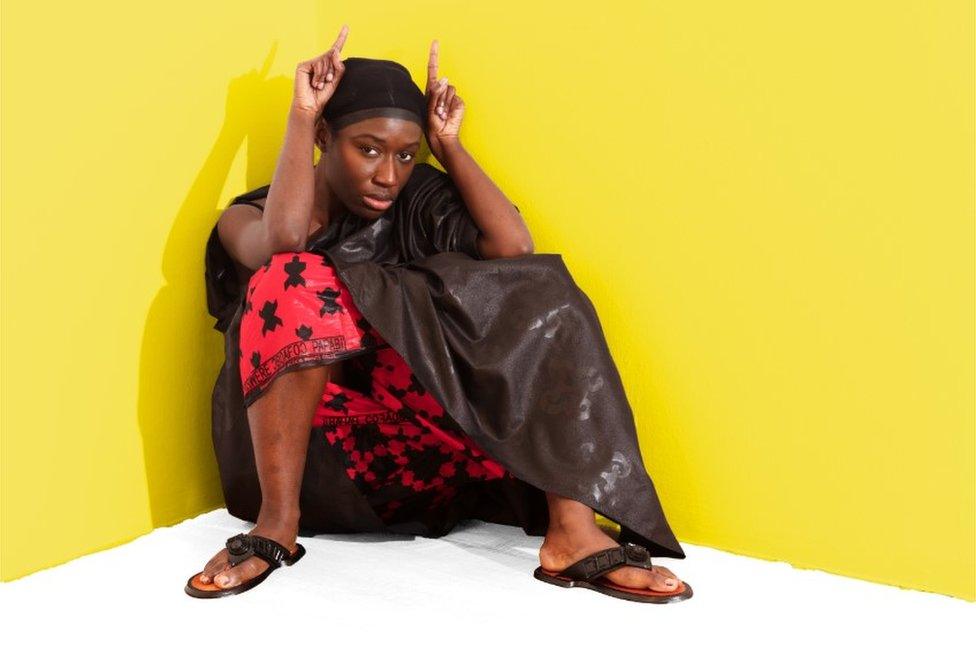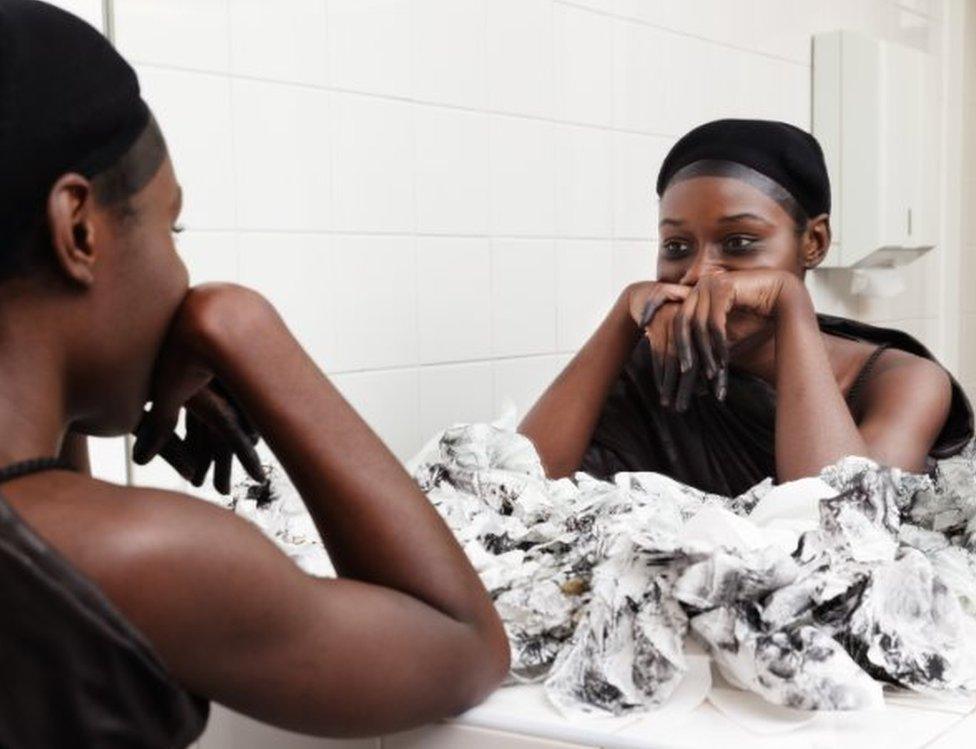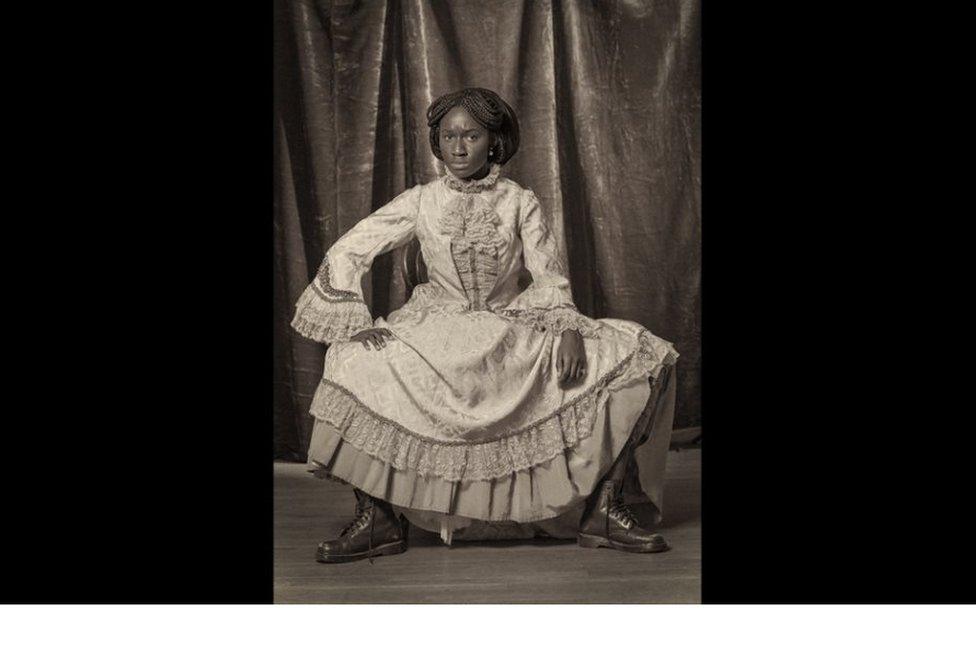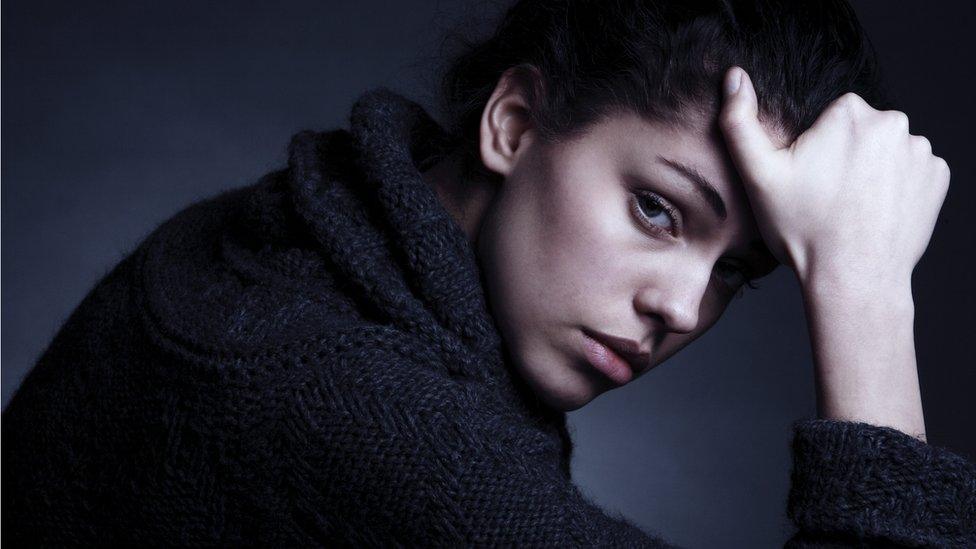The photographer who became a warrior
- Published

The female warrior Yaa is a "badass" according to photographer Heather Agyepong who has re-imagined the leader for images which fall from the ceiling of the Tate Modern in her latest show. They depict strength, but also reveal how the stereotype of the "strong, black woman" led to her own depression.
Agyepong was born and raised in London, the daughter of immigrant parents from the Ashanti tribe in Ghana. Yaa is a celebrated Ghanaian warrior from the same tribe - they may or may not be related.
"My Yaa is a badass, and powerful," Agyepong says. "She goes into spaces and fills them and sometimes I feel like that and sometimes I don't."
As a black, female, artist in the UK, Agyepong admits she doesn't always feel totally at home or equal in galleries or museums and has taken a more personal take on black life to take attention away from "black trauma".
She says people have become used to seeing "slavery, or films about women in pain" and rather than "dwell on this painful situation" she wants her work to reinvigorate and "reclaim" these cultural spaces and help black people feel "empowered".

Her latest project sees the 27-year-old recreate photographs and pose as Yaa.
The warrior, Yaa Asantewaa, led the Ashanti rebellion known as the War of the Golden Stool in 1900.
It was a fight against British colonialism after the British governor demanded the tribe hand over the gold stool - their symbol of sovereignty.
Agyepong says Yaa is a "symbol of pride, tenacity and defiance" in Ghana, but in the London museum she says she has used it, not to "indulge in the spectacle of black pain" but to show fighting spirit and confidence.
The photographer says the project was borne out of research by Cambridge University which found the mental health challenges of black people of African descent were exacerbated when they were not around other black African people.
Agyepong can identify with that having been brought up as part of a black minority in the UK.
She says she has fought against a sense of isolation at times when she has gone into galleries and found very little artwork or staff members that reflect her cultural heritage.
"I thought what does that mean about black creatives in spaces, where they don't see themselves? Are there any mental health implications?"
The work, But We Are Still Here, is part of Tate Exchange, a programme of events which considers how society's perceptions impact the production of culture.
Agyepong has spent the last nine months researching her warrior and musing on what Yaa might do if, like her, she was living in contemporary Britain - "If I was Yaa on the bus when this person said this, what would I do?"

It harks back to a youth, confused with a British-Ghanaian identity and the uncertainty over who she was or meant to be and how she should act.
Her work, she says, reflects her own personal experiences.
"When people talk about Black British female artists it's always about 'all black women' and I'm just trying to say this is about me and if you relate, 'cool'."
She says for years there has been a "silent assumption" that all black women must be strong and this made her believe there was no place for vulnerability, but she now recognises that as a survival strategy.
"My mum came here as an immigrant. She was treated differently and she's black so she was like 'I have to be on survival mode, I can't cry'. I think we're forced to be resilient and then we find difficulties when we're vulnerable."
The "culture clashes" which was one of the many factors which led her to experience depression as a teenager, something she didn't even talk about with her friends because she thought she had to show she was strong and nothing should get to her, even racism.
"Somebody would say something racist and we'd laugh and say 'idiot'," she says. Only later would it dawn on them they had accepted racial prejudice.
It was during a deep-set depression, between the ages of 16 and 22, that she started to use a camera to create artwork.
She took "really bad pictures" of items in her life which helped boost her mental health and says photography has remained a positive outlet even in difficult times.
Her last project, Too Many Blackamoors, may have won plaudits, but it also impacted on her mental health.
The term "Blackamoor" related to black Africans and was referenced in a royal letter sent from Queen Elizabeth to the Lord Mayor of London in 1596 stating there were "too many" and should be expelled.
Agyepong's project told the later story of Sarah Forbes Bonetta whose family was killed in a slave raid in Nigeria in the 1840s when she was just four-years-old.
The girl was gifted to Queen Victoria who adopted her as a goddaughter, provided an education and a place to live in Windsor Castle.
But the photographic work, which Agyepong re-imagined, looked beyond this apparent "happy ending" and at how Sarah may have actually felt about being taken away to live a very different life.

"It was about people experiencing racism in European countries which happened to me the year before [in 2015]," Agyepong says.
"When it was first on the walls I cried because no one knows what I was thinking about during those images. They were saying 'this is great' and I was thinking 'you don't understand'."
She says there are now positive moves in how her community discusses mental health, partly thanks to social media and she hopes Yaa may add to this.
"My friendship groups never used to speak about it five years ago and now we talk about it quite regularly, I can actually feel a shift."
Even though Agyepong's work touches upon mental health, her overall aim is inclusivity.
"We're all in this together and my project is to say 'I see you, I feel the same, I've been through the same thing, it's cool'."
Heather Agyepong's work But We Are Still Here, external will be on display at the Tate Modern as part of Tate Exchange until 26 November.

For more Disability News, follow on Twitter, external and Facebook, external, and subscribe to the weekly podcast.
- Published29 September 2016

- Published20 July 2016
